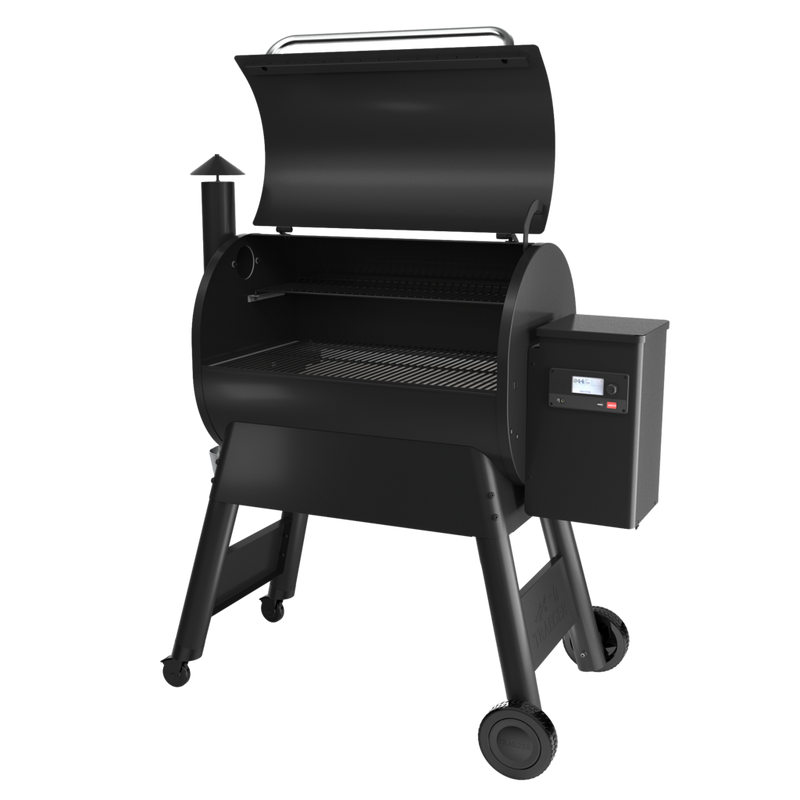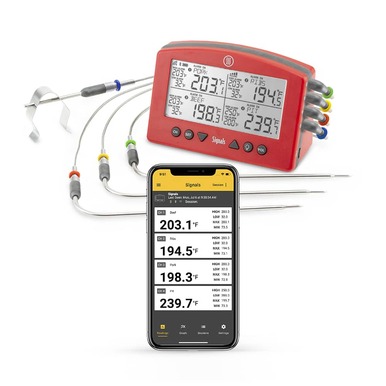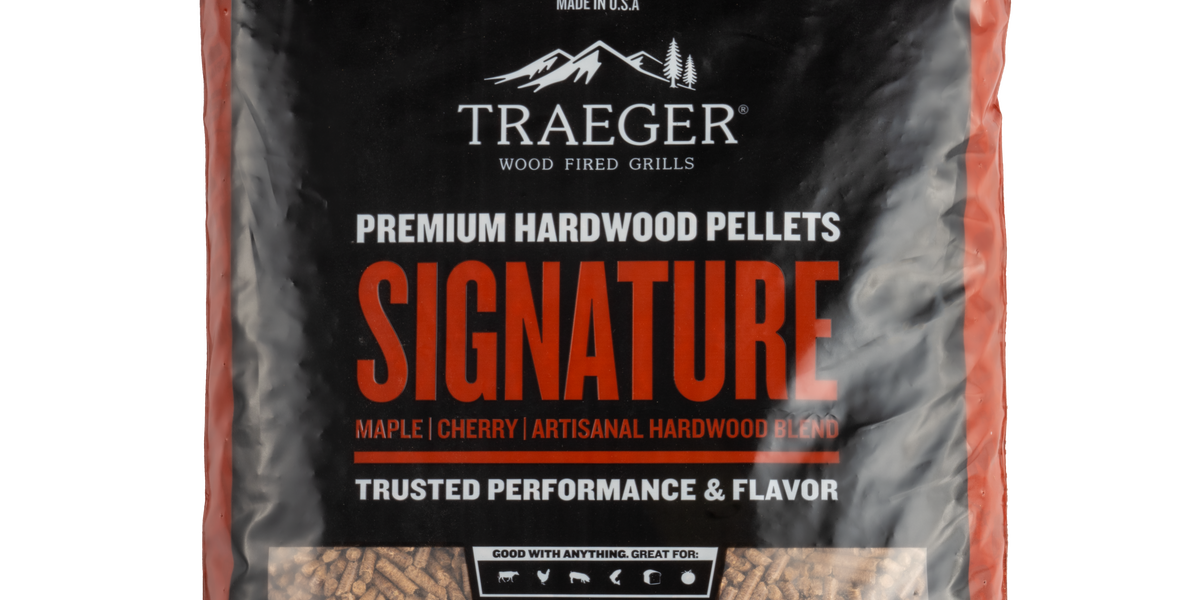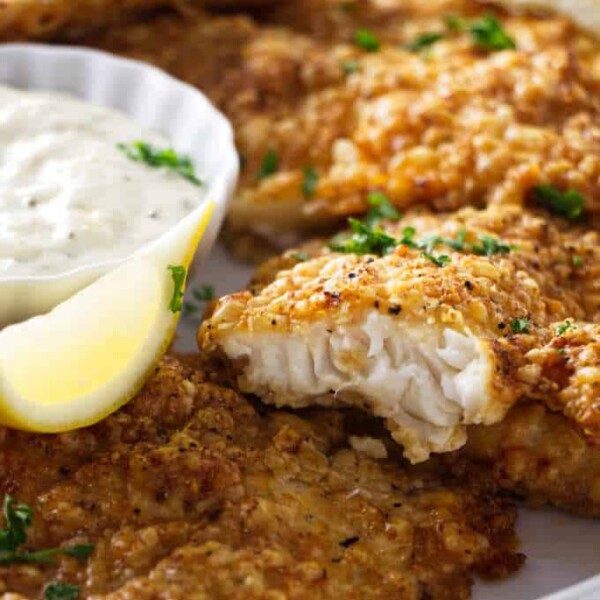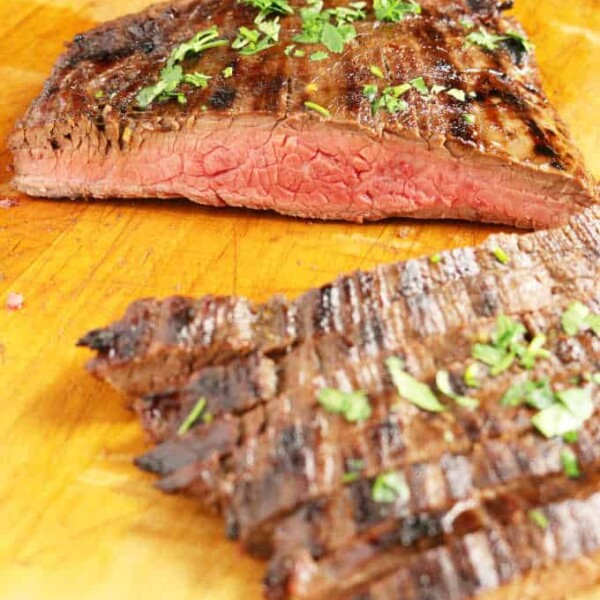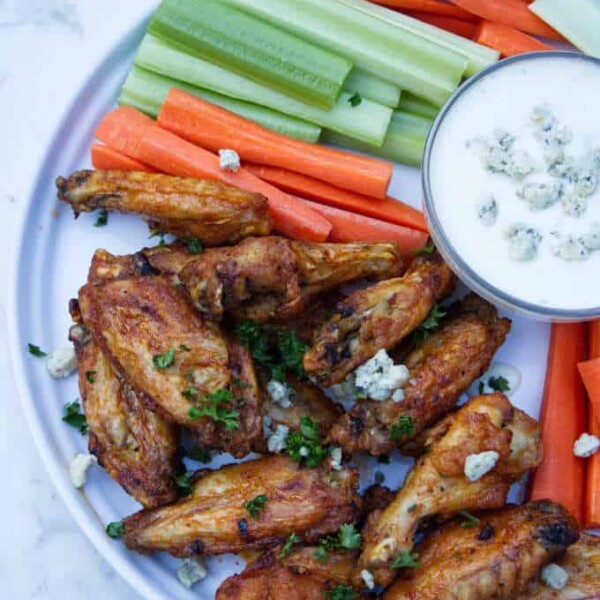Traeger Smoked Beef Short Ribs (Dino Ribs)
on Sep 21, 2021, Updated Sep 21, 2023
This post may contain affiliate links. Please read our disclosure policy.
Fall-off-the bone, tender, juicy, and ever-so-flavorful beef short plate ribs are smoked slowly on a Traeger for delicious brisket on a stick taste.
The mustard rub gives these Traeger smoked beef short ribs a tangy punch while the brandy and apple juice spritz mellow out the flavors.
Beef short plate ribs, sometimes called dino ribs, are super meaty and always make a statement at the BBQ. Perfect for smoking, the otherwise tough meat is jam-packed with a tender beefy taste when you prepare it properly. Follow this recipe for the best results every time!
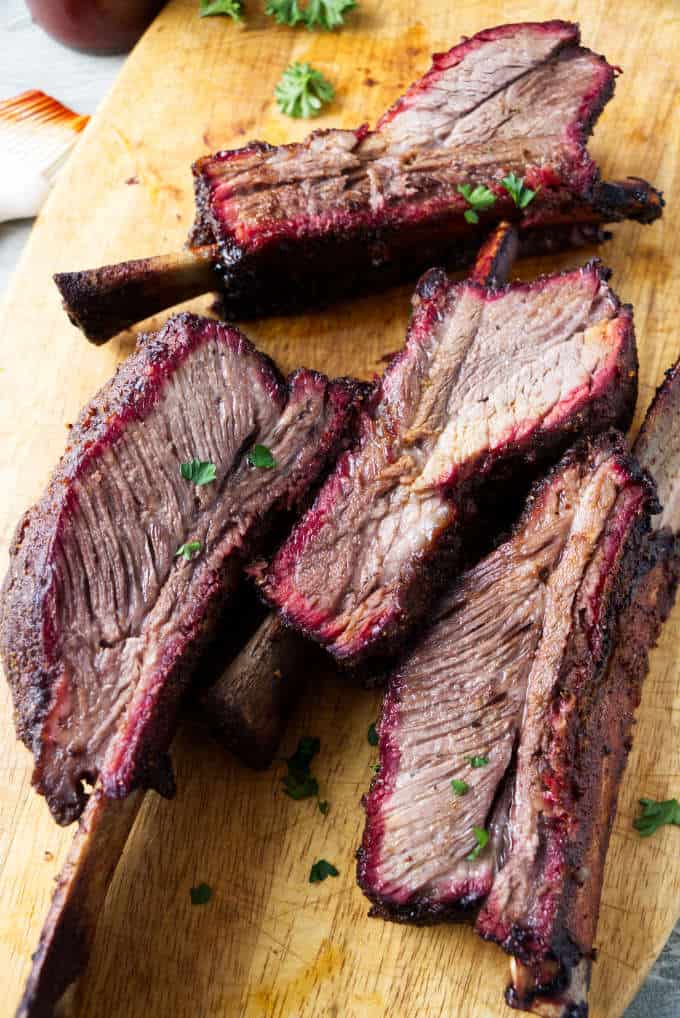
These ribs have so much flavor that you don’t even need barbecue sauce. However, for all you sauce lovers, you can serve them with our Kansas City-style BBQ sauce. Plus, the sauce is terrific with our grilled potato wedges.
Please keep in mind that this recipe is for thick, meaty plate ribs. If you have thinner beef back ribs, you should check out our smoked beef back ribs recipe.
Why This Recipe Is Great
- Fast preparation (under ten minutes)
- Fun to smoke beef short ribs on the Traeger
- Only a few ingredients
- Perfect for cookouts and outdoor parties
- A brandy spritz keeps them moist and adds amazing flavor
Ingredients for Traeger Smoked Beef Plate Ribs
- Rack of beef short plate ribs (other cuts of ribs work too)
- Brown sugar
- Mustard powder
- Smoked paprika
- Salt
- Black pepper
- Garlic powder
- Apple juice
- Brandy

How To Make Traeger Beef Plate Ribs
Step 1: prepare the Traeger
Preheat the Traeger smoker to 250°F. You can use any wood pellets since beef is very versatile. However, most people like to use oak, hickory, maple, or cherry pellets for ribs. I use these Pit Boss Competition Blend pellets because they are very well-rounded and give a great smoky flavor.
Step 2: remove the membrane
Peel the membrane away from the ribs. The membrane is the silverskin connective tissue on the backside of the ribs on top of the bones. I use a butter knife and slowly wiggle the blade underneath the membrane until I can loosen enough of it to grip with my hands. You can use a piece of paper towel or a rag to get a better grip on the membrane. Then, pull the membrane away from the ribs. The membrane may come off in small pieces.
Step 3: prepare the ribs
In a small bowl, mix all of the ingredients for the mustard rub until well combined. Coat all sides of the ribs in the mustard rub and let sit for at least ten minutes. If you have time, allow the ribs to sit in the fridge overnight so that they can brine in the dry rub. Letting them brine longer will help to develop the flavors and make for some incredible Traeger smoked beef short ribs.
Step 4: mix your spritz
Combine the apple juice and brandy in a food-safe spray bottle. You can also use a basting brush or BBQ mop if you do not have a spray bottle.
Step 5: smoke the ribs
Place ribs in a preheated smoker at 250°F and cook for 8 to 10 hours.
Step 6: spritz away
During the last 4 to 5 hours on the Traeger, spritz the beef short ribs with brandy juice solution every half hour or so. The spritz will help to add flavor to the smoked short ribs and keep the bark from burning or becoming too hard.
Step 7: smoke until done
Inset a fork or skewer into the ribs to check if it’s fully cooked. You should be able to pierce the meat of the ribs with very little resistance. You can also check that the internal temperature is between 203°F and 208°F.
I always trust this ThermoWorks Signals WiFi thermometer to tell me when I am done cooking. The Signals thermometer has 4 probes, so you can monitor multiple items, all from the comfort of the couch using the ThermoWorks App on your phone.
For super fast temperature checks, this ThermoWorks ONE Thermapen gives you an accurate reading in only one second! Now you will not have any more excuses for not hitting perfection!
Step 8: rest the Traeger smoked short ribs
Remove the smoked beef short ribs from the Traeger and wrap them in foil or butcher paper. Let them rest for 30 to 45 minutes before serving.
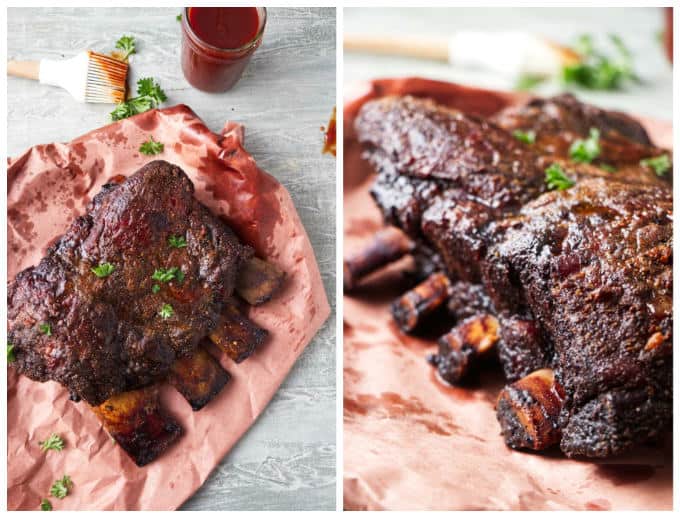
Tips and Tricks
Remove the membrane from the short ribs
Silverskin is a chewy layer of membrane that runs along the backside of the ribs against the bones. Removing this thin layer of connective tissue is optional, but I always do since it does not break down while cooking.
Remove the membrane from the backside of the ribs by using a sharp knife to get under the membrane to loosen it. Then, lift the membrane and pull it off using your hands. It may come off in pieces, but keep working the membrane and peeling away from the bones to remove it.
Coat the short ribs in mustard rub
Cooking the ribs in the Traeger is part of the secret to success, but we have some extra tips for the best smoked short ribs ever. We coated these ribs in a delicious mustard-seasoned dry brine for extra flavor and juiciness.
Letting the ribs sit in a dry brine will help tenderize them and give you much better results. The salt helps the meat retain more moisture and relaxes the protein fibers, making the short ribs even more tender. Using a dry brine is, without a doubt, the best thing you can do for juicy, tender, FALL OFF THE BONE Traeger smoked short ribs.
Spritz the meat
Spritzing during the last half of cooking will keep the ribs moist and evenly cooked. The surface of the ribs is lightly cooled from the liquid, preventing the rub/bark on the exterior from overcooking or turning black. Using a food-grade spray bottle is the modern alternative to a basting brush.
The spritz we used for this recipe has a splash of brandy which gives the ribs a fantastic aroma as they cook in the smoky Traeger. If you want to skip the alcohol, you can use apple juice or vinegar.
BBQ sauce: take it or leave it
You don’t even need to add BBQ sauce on these dino ribs. The rub forms a flavorful, crunchy bark, and the meat will be so tender and delicious that you won’t miss it. These Traeger smoked beef short ribs are delicious either way!

Frequently Asked Questions
Why are my beef short ribs so tough?
It would be best if you smoked your short ribs low and slow to ensure tender meat. If the temperature is too high or cooked too fast, you’ll get tough ribs. Remember, beef short ribs are naturally tough. So, treat them with care and take your time, and you’ll have delicious fall-off-the-bone meat.
What is the difference between beef short ribs and beef back ribs?
Ribs can come from a few different areas of the cow. The primal cuts of the cow that you can get ribs from are the rib, plate, and chuck. All beef ribs are delicious and make great barbecue, as long as you treat them properly.
The beef short ribs that I love to smoke come from the short plate primal cut of the cow. The butcher calls it a short plate because it doesn’t contain the brisket. However, just like brisket, plate short ribs have a thick layer of meat on top of the rib bones, resembling something that you might imagine came from a dinosaur. The meaty appearance is the reason they get their nickname, dino ribs. These are the iconic ribs you see on social media with an excessive amount of meat, oozing juices and teasing your tastebuds.
You can also get short ribs out of the rib and chuck primal cuts of the cow. They are generally not quite as meaty, but they have a delicious, beefy flavor.
Beef back ribs come from the rib primal cut of the cow towards the top dorsal area in the forequarter of the steer. The butcher gets the prime rib, and ribeye cuts come from the same area. Since butchers want to maximize profits on more expensive cuts, beef back ribs generally have more meat carved away from them. If you go to your butcher, you may be able to request extra meaty beef back ribs. Regardless, most of the meat will be between the bones, and the flavor is still out of this world!
Can I substitute other types of ribs?
All beef ribs are delicious when smoked low and slow. You can substitute any ribs in this recipe and still get incredible results. The cooking time will vary depending on how thick your ribs are, so adjust the time accordingly. The best way to tell when your ribs have finished cooking is to use a meat thermometer like this ThermoWorks ONE Thermapen.
What else is cooking?
Did you know the air fryer does a fantastic job at frying ribs? These air fryer beef back ribs are tender, juicy, and finger-licking-good! Perfect for a rainy day when you still NEED to have that barbecue fix.
If you want to make a statement at your next BBQ, cook this whole grilled salmon and show off your fillet skills! This is by far the easiest way to grill salmon on the Traeger. Once the salmon is grilled to perfection, the fillets can easily be peel away from the bone, leaving a super tender and moist piece of salmon. The slight smokiness from the Traeger is so perfect!

CONNECT WITH A LICENSE TO GRILL!
Be sure to follow us on our social media accounts.
Did you make this recipe? Tell us about it in the comments below!
💬 Tell Me What You Think!
Did you try out this recipe? Please leave a comment below and let me know how you liked it. Also, snap a picture and post it to your favorite social platform. Be sure to tag me at @alicensetogrill and let me know how you liked it!
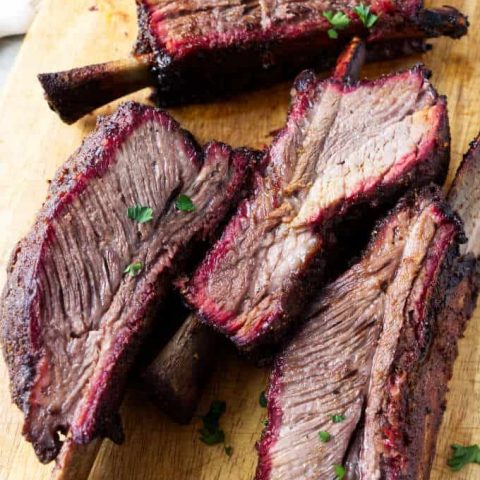
Traeger Smoked Beef Short Ribs (Dino Ribs)
Beef plate ribs are sometimes sold as beef short ribs. They are larger and meatier than back ribs which has them nicknamed as 'dino ribs'. These ribs do especially well with a long slow smoke. By the time they finish cooking, the meat is juicy and fork-tender.
We slathered these ribs in a sweet mustard rub and used an apple brandy spritz while we watched them cook. These ribs are worth the wait!
Ingredients
- 1 rack of beef plate ribs (about 4 to 5 pounds)
For the mustard rub
- 1/4 cup brown sugar
- 2 tablespoons ground mustard powder
- 1 tablespoon smoked paprika
- 1 tablespoon kosher salt
- 1 tablespoon ground black pepper
- 1 tablespoon garlic powder
For the rib spritz
- 1/2 cup apple juice
- 1/4 cup brandy
Instructions
- Preheat the Traeger to 250°F. Use your favorite type of wood. I like to use either Pit Boss Competition Blend pellets or Traeger Signature Blend pellets.
- Turn the ribs over so the bony side is up and peel off the membrane. Use a rounded knife to get under the membrane and loosen it. Once you get it lifted, use a paper towel to hold onto it and pull it off. Sometimes it pulls right off in one piece.
- Generously coat both sides of the ribs in the rub. Let the ribs sit for 10 to 20 minutes to let the rub settle into the meat. You could also let the ribs sit in the fridge overnight with the rub, it will act as a dry brine and tenderize the meat further.
- Combine the apple juice and brandy. Pour into a food-safe spray bottle and set aside.
- Place the ribs in the pre-heated smoker and cook for 8 to 10 hours. During the last 4 to 5 hours, spritz the ribs with the apple juice and brandy solution every 30 minutes or so.
- Check for doneness with a fork or skewer. They will be easy to pierce with a fork and the meat should easily pull away from the bone. If you have a meat thermometer the ribs should be between 203°F and 208°F.
- Remove the ribs from the smoker and wrap them with butcher paper or aluminum foil. Let the ribs rest for 30 to 45 minutes.
Notes
- Use a trusty meat thermometer so you can monitor the cook and ensure the best results. I like to use the ThermoWorks Signals as a leave in thermometer or an instant read like the ThermoWorks ONE.
- The rub will form a crusty bark on the ribs and give it so much flavor you won’t even need sauce.
- The membrane on the back of the ribs is tough and inedible. Peel the membrane off so the flavors can penetrate into the meat.
- The long, slow smoking will break down tough fibers in the meat and make it tender.
- Use a food-safe spray bottle to put the spritz in.
Recommended Products
As an Amazon Associate and member of other affiliate programs, I earn from qualifying purchases.
Nutrition Information:
Yield: 4 Serving Size: 1Amount Per Serving: Calories: 208Total Fat: 8gSaturated Fat: 3gTrans Fat: 0gUnsaturated Fat: 4gCholesterol: 28mgSodium: 1615mgCarbohydrates: 19gFiber: 2gSugar: 15gProtein: 9g
Nutrition information is a guideline only, is calculated automatically by third party software, and absolute accuracy is not guaranteed.
